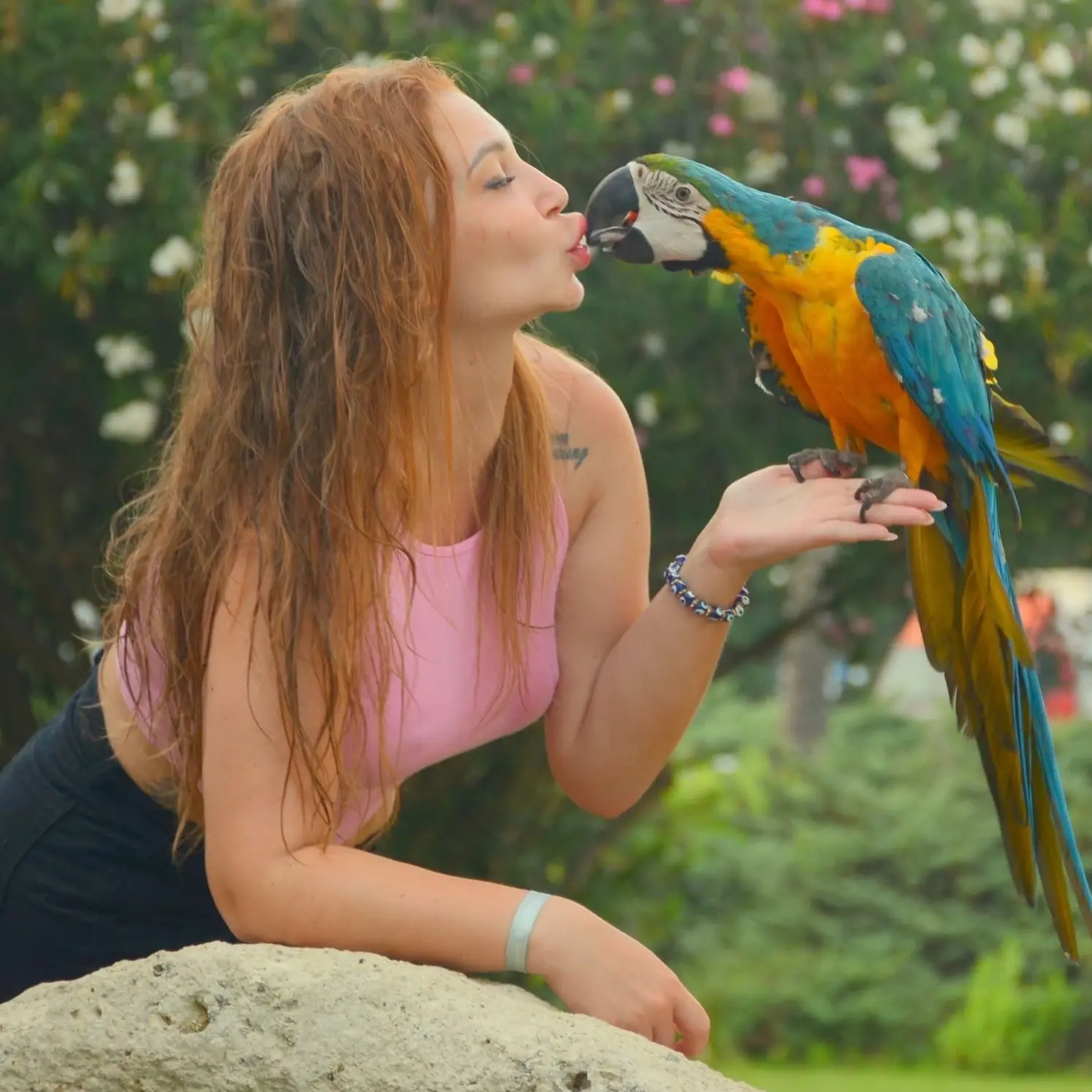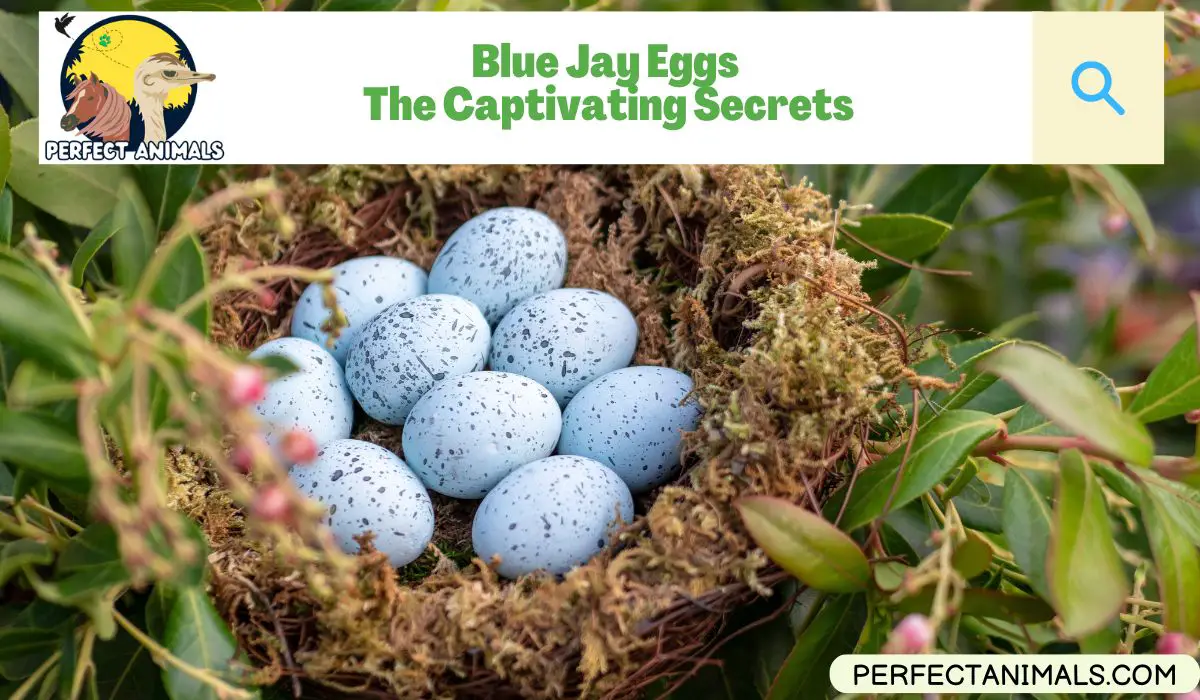Blue jays are familiar backyard birds in many parts of North America, recognized by their bright blue, white, and black feathers.
These chatty songbirds are a delight to watch as they vocalize and hop around in small flocks.
During spring breeding season, one bird behavior you may observe is female blue jays gathering nesting material and eventually producing beautiful olive-colored eggs speckled with brown spots.
The eggs and subsequent hatching process are intriguing for any backyard nature lover.
In this article, we’ll explore some key questions surrounding blue jay eggs and babies to satisfy your curiosity about their nesting and early development.
What Do Baby Blue Jay Eggs Look Like?
A blue jay’s eggs are a light olive green or blue or tan with brownish spots dotted all over. The spots help camouflage the eggs among the twigs, bark, and leaves in a tree nest.
An average blue jay egg is about 1 inch long and half an inch wide with a slightly tapered shape.
The shell has a smooth, slightly glossy texture.
The speckles on each egg are unique in their exact pattern and coloring, much like fingerprints on humans.
When first laid, the eggs may appear quite pale in color.
However, over the incubation period of about 2 and a half weeks, the egg shells acquire more markings and depth of color.
Right before hatching, the blue jay chick can be faintly seen through the transparent shell with its dark eyes visible.
Those tiny eyes gazing out indicate the baby blue jay is ready to peck its way into the world outside.
Related Article – What Birds Lays Blue Eggs?
How Many Eggs Are In a Blue Jay Nest?
A typical blue jay clutch contains 3-6 eggs. The female builds a new nest each breeding season, laying one egg per day over a week or so.
Therefore, you’ll seldom see just one or two eggs in an active nest.
Blue jays have a habit of consuming eggs or nestlings from the nests of other bird species.
Interestingly enough, this protects their nests against similar nest predation since they ensure limited nearby competition.
The more eggs a female blue jay lays, the less likelihood that another hungry bird snatches one of their brood.
So while 4-5 eggs are common, some blue jay nests contain up to 8 eggs.
However that larger brood size stretches the parents’ ability to adequately feed such a full nest.
Sadly the smallest nestlings often perish in large broods when food runs scarce.
So while prolific egg laying seems smart survival strategy, the parents’ nurture determines which chicks survive fledging.
You May Also Like – Red Headed Sparrows
How Long Do Blue Jay Eggs Take to Hatch?
The incubation period for blue jay eggs – the time from the mother laying the eggs to the chick’s hatching – lasts around 16-18 days.
During this 2-3 week period, the female sits on the nest and rotates the eggs frequently.
This ensures even warming as the eggs develop and mature inside their protective shells.
The male blue jay occasionally brings food to the nest but the female is quite attentive to her duty.
Around day 10, if you candle a blue jay egg by shining a light behind it, an opaque mass becomes visible inside as the embryo rapidly develops.
In the last days before hatching, tapping sounds might emit from the eggs as the baby jays peck their growing beaks against the interior shell walls.
This pipping helps the hatchlings chip away until they fully emerge.
So in general, once the female lays her clutch of 3-6 eggs, expect tiny little blue jay nestlings to begin breaking out around 16-18 days later.
Then the real fun begins for bird-loving nest observers!
You May Also Like – How Bird Poop Good Luck Can Boost Your Destiny
Can You Touch a Baby Blue Jay?
It’s understandable to want to touch a baby blue jay since they are so enticingly cute and tiny.
However, it’s actually illegal to handle the birds under the Migratory Bird Act.
There are also health considerations for both you and the delicate hatchlings.
Baby blue jays have very thin sensitive skin and cannot maintain their body heat well.
Human hands are very warm and can overheat the nestlings quickly, even fatally.
Our skin oils and residue may clog the feather pores too.
Touching the juveniles may also cause the parents to abandon the nest out of fear due to human scent.
Furthermore, the chicks have poorly developed immune systems and can easily acquire diseases from people.
The best approach is to simply observe the nest, enjoy watching the blue jay family dynamics, and let the parents raise the youngsters undisturbed.
If a baby falls from the nest, the best solution is to call a licensed bird rescue organization for advice rather than attempting amateur rehabilitation.
Let the professionals handle any interventions.
You May Also Like – Why Do Owls Hoot?
What To Do If You Find Blue Jay Eggs?
So you were out for a walk and stumbled upon a blue jay nest with eggs inside. What should be your next steps?
Resist the urge to touch the eggs! As mentioned earlier, human interference can distress parent birds and harm the emerging young.
Plus taking native birds or eggs is prohibited without permits.
Your best option is to leave the area promptly and avoid startling the parents.
Do not linger observing the nest. Adult blue jays will avoid the nest if they sense recurring danger, jeopardizing their unhatched brood.
Mark the spot in your mind so you can detour around it in the future. Do not intentionally approach the nest again during the weeks-long incubation and rearing cycle.
If the eggs or hatchlings become imperiled by weather, predators, or accidental falling from the nest, calling a wildlife rehabilitator is appropriate.
Licensed experts know how to intervene cautiously when rehabilitation is truly merited.
So in summary – avoid, avoid, avoid! Give found blue jay nests a wide berth and let nature take its course unless true emergency surfaces require rehab expert assistance.
The parents know best about raising their young.
You May Also Like – Top 10 Birds With Long Beaks
Can You Eat a Blue Jay Egg?
While their eggs may seem like tempting exotic delicacies, it is illegal and unethical to consume the eggs of any wild bird like blue jays.
The Migratory Bird Treaty Act classifies native bird species as protected, making taking their eggs or nests punishable by hefty fines.
This applies to both adult birds as well as juveniles and eggs.
Beyond legal restrictions, consuming the egg of species like blue jays has questionable nutritive value and safety implications.
As carnivorous birds subsist largely on insects, their eggs likely contain comparatively higher levels of environmental toxins which become biomagnified food chains.
Finally, since blue jays play important ecosystem roles like scattering seeds and controlling pest populations, unchecked harvesting from wild populations for food could negatively impact delicate ecological balances.
Their value of thriving in nature outweighs any minimal merits of poaching eggs.
So while you may be curious about the flavor, the welfare of the overall species along with legal deterrents should curb any appetites for this protected bird’s eggs.
Best just to observe them in their oval magnificence sitting snugly in a tree nest!
Related Article – 12 Clever Birds That Eat Spiders
Final Thoughts
Watching dazzling blue jays frequent your yard is entertaining enough on its own. Yet witnessing the nesting process unfold each spring takes that spectacle to a whole new captivating level.
The parents work tirelessly to create protective sanctuaries for their spotted olive eggs.
While resisting the urge to interfere, we can quietly observe their nest preparation, brooding diligence, and eventual proud emergence with hungry hatchlings.
Gaining some key insights around the physical traits of blue jay eggs, incubation periods, ideal clutch sizes, and proper legal protections allows us to appreciate the avian reproductive miracles playing out annually in our backyards.
Blue jays represent just one common example of the wondrous bird breeding ecosystems at work across so many neighborhoods.
As we respect the delicate natural balances enabling favored songbirds like jays to thrive, we ensure our children also inherit habitats graced by their elegant beauty and daily antics.
The iconic blue dashing acrobatically from tree to tree may have more critical matters than acorns on its mind!
FAQs
Why do the Blue Jays abandon their nest?
Blue jays may abandon their nest due to threats like habitat loss, lack of food sources, predators, or too much disturbance from humans.
Do Blue Jays leave the nest before they can fly?
No, blue jays do not leave the nest before they can fly. The young fledge the nest at around 17-21 days old when they have enough wing feathers to fly short distances.
Why is my baby blue jay jumping out of the nest?
If baby blue jays are jumping out early, the parents may be struggling to feed the brood, the nest is overly disturbed, or predators are threatening the area.
Premature fledging before the young can truly fly often has dire consequences.
What is the lifespan of a blue jay?
In the wild, blue jays typically live about 7 years on average, though some exceptional jays reach over 16 years.
Their lifespan is much shorter than many backyard birds due to threats birds face in nature over time.
Resources – (for further reading)
Wikipedia – Blue jay
All About Birds – Blue Jay – All About Birds
National Audubon Society – Blue Jay | Audubon Field Guide

Lisa W. is a devoted bird lover, especially fond of her pet macaw, Sakkari. With a multitude of pet birds, she’s well-versed in bird care and behavior. Lisa has actively contributed to bird conservation and habitat restoration through her published research papers. She passionately shares her insights by crafting engaging articles for our site.

